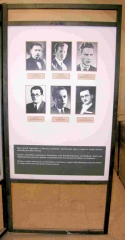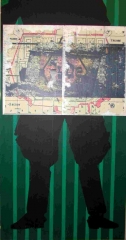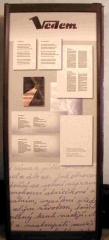Temporary exhibitions available from the Terezín Memorial
November 17th 1939
The spontaneous demonstrations by Praguers on the national holiday marking Czechoslovak independence on October 28th 1939 were an expression of resistance to the occupation of the Czech Lands by Nazi Germany. Among those wounded in the suppression of the demonstrators was medical student Jan Opletal, whose funeral on November 15th became another occasion for a large protest, in particular by students and university lecturers. In retaliation, German security forces moved against universities on November 17th 1939 – nine student leaders were executed and more than a thousand students interned and sent in particular to the Sachsenhausen concentration camp. At the same time, all universities within the Protectorate of Bohemia and Moravia were closed until the end of the War. The exhibition considers the persecution of Czech and Moravian students during the years of the Nazi Occupation, describing their deportation and life in the concentration camps.
The authors of this exhibition are Miroslava Langhamerová and Marek Poloncarz.
Number of panels: 22 Panel size:100 x 210 cm
Alfred Kantor, Terezín – Auschwitz – Schwarzheide. The Holocaust in an artist’s diary
Alfred Kantor (born November 7th 1923 in Prague) entered the Rotter School for Advertising Graphics just as the occupiers ordered the exclusion of all Jews from private and public schools in June 1940, and was therefore obliged to interrupt his studies. On December 1st 1941 he received his summons for transport to Terezín, where he remained until 1943. He was subsequently deported to Auschwitz, and then in 1944 to the Schwarzheide work camp. After Liberation, he stayed in the camp for liberated prisoners at Deggendorf in Bohemia; it was here that he created a set of drawings that provide unique pictorial documentation of the Terezín Ghetto, the Auschwitz-Birkenau concentration and extermination camp, and the Schwarzheide work camp.
The selection of drawings by Alfred Kantor for this travelling exhibition was made and annotated by Vojtěch Blodig.
Number of panels: 20 Panel size: 106 x 200 cm
The Family Camp
The largest complex of Nazi extermination camps was built during the Second World War at Auschwitz in Upper Silesia (Poland). One component comprised the Auschwitz II – Birkenau camp, which became infamous as the largest of the extermination camps, and where some 1.4 million people (of whom 1.1 million were Jews) were put to death. This was the destination for transports from the Terezín Ghetto between October 1942 and October 1944. Between September 1943 and May 1944 the Terezín prisoners were house in the “family camp”, which had been prepared for propaganda purposes. Ultimately its purpose came to nothing, and the majority of the prisoners housed there died in the gas chambers of Auschwitz. This exhibition looks in particular at the fate of prisoners from the transports that arrived at Auschwitz from Terezín in September 1943, and who were put to death on the night of March 8th-9th 1944. Their execution was the largest mass murder of Czechoslovak citizens to take place during the years of the Nazi Occupation.
The exhibition authors are Vojtěch Blodig and Tomáš Fedorovič, who used material compiled by the late Miroslav Kárný, himself a former prisoner.
Number of panels: 31 Panel size: 75 x 200 cm
Vedem
The fate of the youngest prisoners in the Terezín Ghetto – which from 1941 to 1945 served as a collection and transit camp for Jews from what was the Protectorate of Bohemia and Moravia, as well as from other European territories occupied by the Nazis – is one of those pages of history that speaks most eloquently to the generation of today. Even given the conditions of camp life, these young people, pre-ordained to death by the Nazis, did not give up their humanity, their personal integrity or their hope of a better life after the War. From 1942 to 1944, some of the boys imprisoned in the ghetto published, in one or more copies, the magazine Vedem (“We lead”), which contained poetry, stories, essays, reports and other literary endeavour by the youngest of the inmates. This exhibition highlights the fates of some of the creators and contributors, as well as including a selection from their work, astonishing in its maturity and high standard.
The authors of this travelling exhibition are Kurt Jiří Kotouč, formerly one of the creators of Vedem, the literary historian Marie Rút Křížková and the Israeli painter Chava Pressburger, sister of the magazine’s chief editor, Petr Ginz.
Number of panels: 42 Panel size: 90 x 215 cm
For further information, please contact:
e-mail: vesely@pamatnik-terezin.cz



